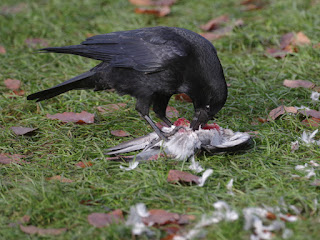The Black Swan was in the middle of a crowd expecting to be fed. Although it's considerably smaller than a Mute Swan, its neck is very long and it can reach as high as any of them.
The elusive Little Grebe appeared momentarily under the willow tree near the bridge.
A cold day kept people out of the Diana memorial fountain, and a young Herring Gull took the opportunity to enjoy paddling in the rapids.
Another Herring Gull found a crayfish in the Serpentine, and was harassed by Carrion Crows trying to grab it.
One crow managed to get a leg that had fallen off.
At the other end of the lake, the pigeon-eating Lesser Black-Backed Gull had also found a crayfish, needless to say a bigger and better one.
The number of crayfish in the lake is cyclical: they gradually increase and then there is a die-off and they disappear for a year or more. Mateusz at Bluebird Boats monitors the population by trapping crayfish in a net, later releasing them, and he told me that numbers were up again. But the fact that two gulls had one within minutes of each other suggests that they are now dying and being washed up on the shore.
A Common Gull gave the camera a hard stare, though it does seem that the placement of their eyes means that can't see clearly straight ahead. Other gulls have slightly more forward-set eyes.
A Magpie on a railing showed off the blue and green iridescence of its wing coverts and tail.
A Carrion Crow in the Rose Garden ate a pigeon that had been killed by a Sparrowhawk, as the scattered feathers show.
This is the Coal Tit in the Rose Garden that is usually waiting on a twig while I fill up the feeder with sunflower hearts.
A Blue Tit near the bridge was also expecting service.
The hawthorn trees just to the west of the Italian Garden are a favourite stop for flocks of Long-Tailed Tits. They must have a lot of insects in them.
This planter at the Lido restaurant is clearly infested with some kind of small creatures, which a Starling enthusiastically dug up.











Hi Ralph, thank you so much for your wonderful blog. I was down on the Long Water today and noticed that a glorious pair of mandrin duck had flown in. They were located near the bank between Peter Pan and the Italian Garden. Do you mind if I ask you if you have seen them before and if they are common visitors? Thanks.
ReplyDeleteThank you. They're frequent but irregular visitors. They nest here too, usually unsuccessfully but two ducklings survived a few years ago. Their main territory is the Regent's Canal between Paddington and Regent's Park.
DeleteInteresting as always, does anyone know what kills off the crayfish?
ReplyDeleteIn 2008 it seems to have been an accidental spill of algicide from the Diana fountain. This is deadly to crustaceans and all the crayfish were dead in hours. But there has been another die-off since then, cause unknown.
DeletePoor Crayfish. Although their loss is the Gulls' gain.
ReplyDeleteHow lovely the picture of the Long Tailed Tit against the green backdrop! I keep telling it can't get any cuter, and I keep being proven wrong.
Maybe that Common Gull is just short-sighted. I know that without my glasses I have a major case of death stare, but the truth of the matter is that I just cannot see my hand in front of my face. The other Gull at the fountain looks for all the world like a kid at an amusement park.
A very warm welcome to the Little Grebe!
I've taken several straight-on pictures of Common Gulls, and they all seem to have these faces where you can only just see both eyes, while with other gulls both eyes are reasonably visible. But binocular vision is not all that important to birds, since their eyes are close together, and they rely on parallax to judge distance. Even the smaller owls have to bob their heads to get a good sense of distance.
DeleteWell done on the Wigeon. I think I've seen one on the Long Water once before, but I'm a rare visitor myself to the park. They are beautiful ducks + I just love the whistle of the male. We used to get good numbers in Richmond Park but are now much scarcer + fewer in number these days, though we have had high numbers of Shoveler + Pochard recently.
ReplyDeleteInteresting to see the gulls with the crayfish. Do you know which of the various alien species they are?
They're Turkish Crayfish. There used to be Signals too, but they seem not to have recovered from the last crash.
DeleteThanks Ralph.
ReplyDelete